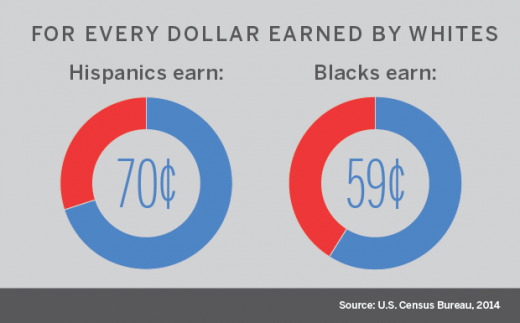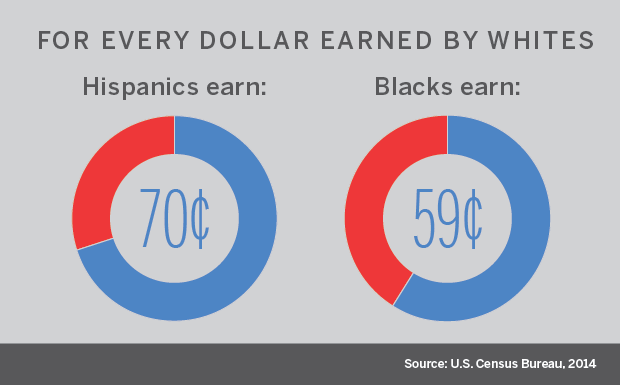The Business Case For Diversity In The Workplace
May 1, 2016

Did you know that diverse companies outperform non-diverse companies by 35%?1
Besides the many financial benefits, isn’t hiring a diverse workforce the right thing to do?
It’s amazing that in 2016, we’re still having issues with diversity in the workplace.
Thanks to the internet, business is more global than ever, which means that you need to understand how these different types of customers think, which means you need different types of employees helping you understand how they think.
When people from all different backgrounds come together, they bring different perspectives, information, and worldviews. This mix creates more innovation and a more productive team.
But most people know this, so why is this still such a big issue?
The short answer? Our unconscious biases.
Our biases are hard for us to control or change, but there are many companies like Google and Facebook that are working hard to fix this.
Our Unconscious Biases
There are so many biases that we have when we hire someone that leads us to make poor or unfair hiring decisions.
Let’s look at a few of the most common biases that affect our hiring and then look at an innovative solution to fix this.
- Confirmation Bias: This is when people create a hypothesis and then are only focused on proving it right, ignoring any information that might prove it wrong. As an example, if an interviewer sees that a candidate didn’t attend college, they might perceive them as less competent than they actually are.
- Effective Heuristic: This is basically “judging a book by its cover”. If a candidate walks in with tattoos or piercings, the interviewer might make judgments about them that simply aren’t true. These judgments lead us to potentially ignore amazing candidates.
- Expectation Anchor: This is when an opinion is formed about a candidate before the interview even occurs, and then their feelings are anchored towards good or bad, and they have a hard time deviating from that feeling. This leads to some candidates being perceived as better or worse than they really are.
- Intuition: This is when an interviewer selects a candidate based on their “sixth sense” rather than objective information.
These biases have major implications in terms of how we hire and who we choose to hire.
In one study2 , when science teachers were given the same resumes with male and female names, they thought the males were more competent and offered them $ 4,000 in higher salary.
In another incredible study3 done in 2003, researchers sent out close to 5,000 resumes for different positions like sales, support, marketing, etc.
Each resume was randomly assigned a “white-sounding name” or an “African-American sounding name”. The researchers found that applicants with white-sounding names got 50% more callbacks than African-American sounding names.
In a follow-up study done in 20154, the researchers found that candidates with African-American sounding names from elite universities did only as well as those with white-sounding names from less-selective schools.
Think of this statistic:

So what can we do about all of this?
The answer is to make the hiring process as “blind” as possible. The more you can remove yourself from the process, the less biased you’ll be.
There are three companies that are working hard to make blind hiring easy for companies:
These software companies are using their technologies to hide certain information when recommending candidates to employers, and only focusing on skills or results of tests.
This allows companies to fight those biases.
Workplace Diversity Research
Workplace diversity can lead to better financial results. These are only a few of the pieces of research that show how diversity leads to better results, but there are plenty more studies that show this.
In one study5, sociologist Cedric Herring found that companies with the highest levels of racial diversity had, on average, 15 times more sales revenue than those with the lowest levels of racial diversity.
Herring found that for every percentage increase in the rate of racial or gender diversity, there was an increase in sales revenues of approximately 9 and 3 percent, respectively.
A study at the Kellogg School of Management6 found that diverse teams outperform homogeneous ones because the presence of group members unlike yourself causes you to think differently.
In a Catalyst report called The Bottom Line: Corporate Performance and Women’s Representation on Boards7, researchers found that Fortune 500 companies with the highest representation of women board directors performed better financially than those with the lowest representation of women on their board of directors.
And like I mentioned at the beginning of the post, McKinsey found that diverse companies perform at least 35% better than their homogeneous counterparts.
Diversity Examples From Companies
There are many companies that are doing some very cool things in terms of making sure that diversity is a core part of their company.
Google, Facebook, Linkedin, and many other (mostly tech) companies are making a concerted effort to take diversity seriously, largely because of some of the bad press they’ve received in the last few years.
The two companies I’d like to focus on are Google and IBM.
Google’s mini-site about diversity is very well done. You can see how seriously they’re taking diversity, and how much research they’re putting into fighting this problem.
They commissioned a study to find out what are some of the main drivers that make young women pursue degrees in computer science, in the hopes of getting more women to pursue it.
They also have unconscious bias workshops to help Googlers address the problem.
IBM
In my post about 10 books every leader should read, I highlighted a book called “Who Says Elephants Can’t Dance?”, which is about Lou Gerstner and IBM’s historic turnaround in the mid-90’s.
One part of that story that doesn’t get much attention was Gerstner’s focus on diversity as a strategy.
While IBM was already pretty progressive in terms of diversity at the time, Gerstner felt that it wasn’t good enough.
So at the time, he created a “diversity task-force” which became a key part of IBM’s HR strategy.
IBM created eight task forces, each focused on a different minority group like Asians, gays and lesbians, and women.
Now, the number of female executives worldwide has increased by 370%, the number of gay, lesbian, bisexual, and transgender executives have increased by 733%, and the number of executives with disabilities more than tripled.
Leaning In Together
I’m sure many of you are familiar with Sheryl Sandberg’s book Lean In that was all about women taking more charge and getting more credit for work that they do.
Now there is an effort to have men “lean in” and help support women to get the respect they deserve.
Here are some tips to help men lean in on behalf of their female colleagues.
I’m proud to Lean In on behalf of all the women in my life, are you?
Proud to do my part for the women in my life. https://t.co/PhmMZi7LYv #LeanInTogether
— Jacob Shriar (@JacobShriar) April 11, 2016
Any Diversity Stories To Share With Us?
Let us know in the comments below!
Business & Finance Articles on Business 2 Community
(24)














